Part Analysis
| General Data | |
| Manufacturer (OEM) | Super Flower |
| PCB Type | Double-Sided |
| Primary Side | |
| Transient Filter | 4x Y caps, 3x X caps, 2x CM chokes, 1x MOV |
| Inrush Protection | NTC Thermistor SCK-0512 (5 Ohm) & Relay |
| Bridge Rectifier(s) |
2x GBUE2560 (600V, 25A @ 140°C)
|
| APFC MOSFETs |
3x Infineon IPA60R120P7 (650V, 16A @ 100°C, Rds(on): 0.12Ohm) &
1x Syncpower SPN5003 FET (for reduced the no-load consumption) |
| APFC Boost Diode |
1x
|
| Bulk Cap(s) |
1x Rubycon (450V, 800uF, 3,000h @ 105°C, MXT)
|
| Main Switchers |
4x Infineon IPB50R140CP (550V, 15A @ 100°C, Rds(on): 0.14Ohm)
|
| APFC Controller |
On Semiconductor NCP1653A
|
| Resonant Controller | S9602 |
| Topology |
Primary side: APFC, Full-Bridge & LLC converter
Secondary side: Synchronous Rectification & DC-DC converters |
| Secondary Side | |
| +12V MOSFETs | 16x Vishay SiRA54DP (40V, 60A @ 70°C, Rds(on): 2.35mOhm) |
| 5V & 3.3V | DC-DC Converters: 4x Alpha & Omega AON6516 (30V, 25A @ 100°C, Rds(on): 5mOhm) PWM Controller(s): 2x ANPEC APW7073 |
| Filtering Capacitors | Electrolytic: 5x Nippon Chemi-Con (105°C, W), 5x Nippon Chemi-Con (6-10,000h @ 105°C, KZM), 6x Nippon Chemi-Con (1-2,000h @ 105°C, KRG), 1x Nippon Chemi-Con (2-5,000h @ 105°C, KZE) Polymer: 26x Nippon Chem-Con |
| Supervisor IC | JTC113 |
| Fan Model | ZIC ZFF142512D (140mm, 12V, 0.65A, Fluid Dynamic Bearing Fan) |
| 5VSB Circuit | |
| Rectifier |
1x PFC PFR20L60CT SBR (60V, 20A)
|
| Standby PWM Controller | 29604 |
The PCB is small and overpopulated on the secondary side, but all electrolytic caps are in the open without anything blocking airflow. The good airflow will help them since they are close to the 12V FETs, which will get pretty hot under high loads. What I don’t like so much is the vertical PCB hosting the fan header, which looks fragile if you want to remove the fan’s cable. This design that Super Flower used in the past in the EVGA Leadex-based units led to the failure of some of my review samples until I decided to enhance the base of this vertical PCB with silicone before I attempted to remove the fan header.
The blue PCB looks nice, and to save space, Super Flower installed the VRMs, generating minor rails on it instead of a vertical board. This is something I didn’t meet before, as I recollect, at least since something may slip after thousands of PSU reviews.
On the primary side, besides the APFC converter, four FETs, arranged in a full-bridge topology, chop the incoming signal to feed the main transformer, which provides power to the secondary side. An LLC resonant converter is also used to minimize switching losses. Sixteen (!) FETs handle the 12V rail on the secondary side, and two DC-DC converters generate the minor rails.
The soldering quality is good, especially for an early production unit, and all parts that SF used are of high quality, including the FETs and the capacitors. As for the fan, this is provided by a relatively new and promising, as it seems, brand. Let’s see if a new brand will question Hong Hua’s dominance in the PSU fan market.
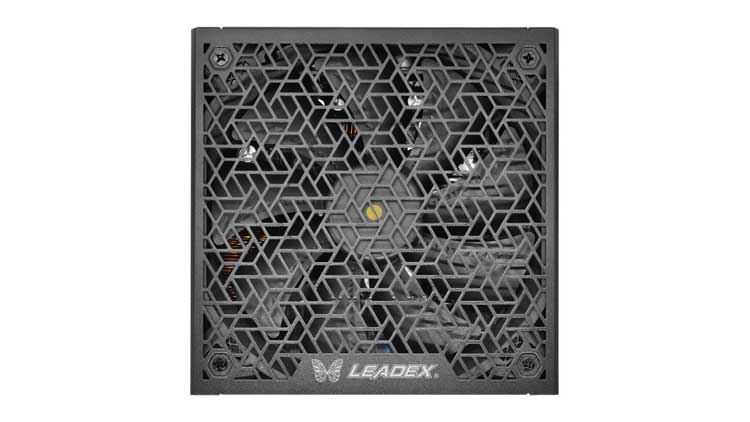
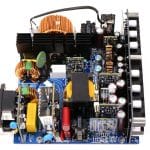
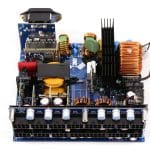
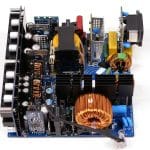

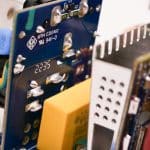


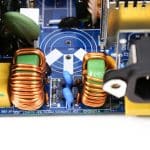
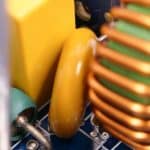
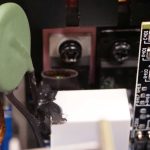
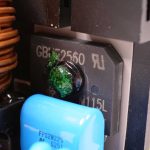
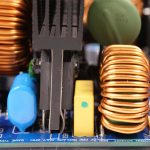
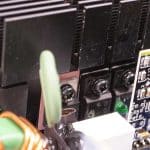
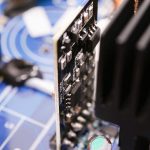
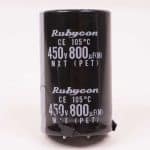

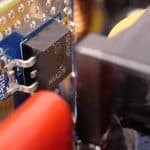
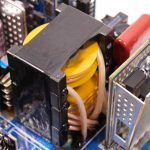
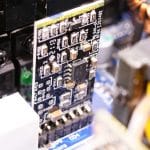
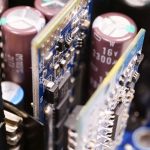
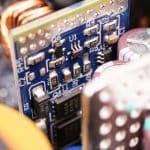
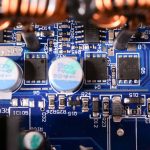
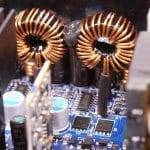


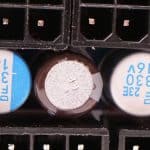

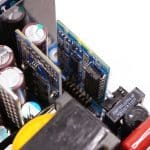
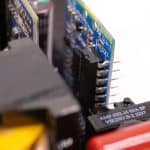


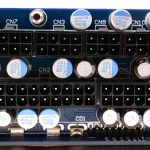
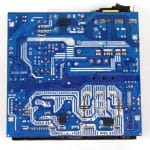
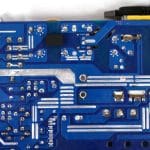

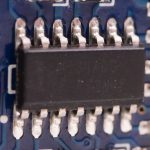
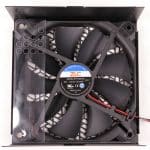
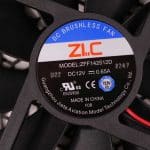


Hello Aris,
It seems the PSU side pin layout/connectors are different from the actual product one. In the product, SF uses 9-pin universal connectors, that’s different from the ones that’s pictured here even though the model number matches. Will that affect performance/ratings of the PSU?
Also, those proprietary connectors aren’t custom cable friendly either, so that’s a bummer.
Hi! Indeed, SF made changes to the final product in the modular panel. Performance isn’t affected.
Thanks a ton, Aris!
Is the SF-850F14XP the same unit as the one you are reviewing? Could you please advise, the quality should be the same? With almost no downsides?
I want to buy this unit only for 850 or 1000W. Please help me to understand, this power supply unit has the marking SF-850F14XP (or SF-1000F14XP respectively)? Because you have other blocks with similar name and the quality (based on cons) is worse. I’m talking about your Super Flower Leadex VII PRO 850W ATX v3.1 PSU and Super Flower Leadex VII PRO 1000W ATX v3.1 PSU Review
How to be?
SF recently changed the naming schemes again. Last time I talked to them the VII Pro was the same as the VII XP or at least this is what I remember them telling me.
I apologize for one more question, but there is no one to ask, and you have a lot more credibility than the rest of us.
Super Flower Leadex VII XP 1200W ATX v3.0 – this PSU you reviewed is perfect) judging by the “Cons” column. Can you express a subjective opinion on my question based on your years of experience.
This same PSU, only at 850W (Super Flower Leadex VII XP 850W) – is it highly likely that the internals and tests will be the same as the Super Flower Leadex VII XP 1200W ATX v3.0? How likely is it to be just as good?
Or can often the same PSU (just with less power) be much worse than its bigger brother?
If things are as you say (or they are), then it turns out the review on your PSU channel is irrelevant? Because if you look at the Super Flower Leadex VII XP 1200W ATX v3.0 it’s perfect, but if you look at the Super Flower Leadex VII PRO 1000W there are a lot of Cons:
Cons:
Expensive
12V OCP and OPP triggering points need to be set lower at high operating temperatures
Sky-high inrush currents at 230V
Ripple suppression could be better on the minor rails
The fan speed profile should be less aggressive at high loads
The APFC converter needs tuning for higher PF readings at 230V
Not efficient 5VSB rail
High vampire power
What to do)).
I’m sorry i’m not very knowledgable in PSU and someone at a local shop suggested me the Super Flower Leadex VII XP 1200W.
is what you just said a good thing? i’m currently building a high end PC with a 9800x3d with hopefully a 5090.
Kinda afraid to buy something i don’t know much of the brand and not much review overall exept i know HWB is very reliable according to these things but their seems to be difference in what model they advertise.
This PSU is top-notch!
I bought it something i found that was different is the connectors are all 9 pins behind now exept for the motherboard.
My 5080 astral came with the small cable with 12pins+4 cable that split into 3. The PSU came with a 12pins+4 cable that split into 2x 9 pins, it says 600w on it. you think it’s safe to use directly to the psu without using the small adapter nvdia gave?
Is it ATX 3.1 meaning does it have the updated safer header on the PSU for an RTX 5090.
I read your article and you mentioned cable is same but the PCB header/connector on PSU and GPU is what matters and all RTX 5090s have the updated better 12V 2X6 safer more reliable PCB/header/connector.
You also mentioned seven some ATX 3.0 PSUs have it.
Is this one of them?
PSUs that don’t use a native 12V-2×6 but have 2x 8pin on their modular panels are automatically v3.1 if they meet the rest specs (except hold-up time which is looser in the newest spec)
I understand that it meets atx 3.1 specifications, but do you know if the end of the cable that plugs into the GPU is 12VHPWR or is it 12V-2×6? The revisioned 12V-2×6 end connector insures proper contact when plugged in with its longer power and ground pins and shorter sense pins. Nowhere for the Super Flower Leadex VII XP Platinum Pro is it mentioned. When I compare the included PSU cable though, the pins do indeed look more recessed when compared to a verified 12V-2×6, implying that the included PSU cable connection is 12VHPWR and puts the connection at more risk in high power situations.
If you know please get back to me <3
the cable is the same. Only the headers on the GPU or the PSU changed.
Hi,
“Buy Super Flower Leadex VII XP 1200W” button leads to Newegg page with a PRO version of this model which is very different (unknown to me at the time of order). I didn’t see 1200W PRO review on this site (is there one?), however, according to 1000W PRO version review the PRO model is way worse than non PRO.
Should I cancel the order of Super Flower Leadex VII XP 1200W PRO?
I am very confused too. I can only find the VII Pro on the internet with the SF-1200F14XP SKU from the XP
The VII Pro is also good. They renamed a model I think. I will ask them again because SF’s model names are a complete chaos!!!
I talked to SF about this. the XP is the Pro!!! They renamed it…
So the Super Flower Leadex VII XP PRO from Neweggs is indeed the one you reviewed? You think it’s worth and is highend enough for a 5090/9800x3d combo?
leadex vii xp1200 platinum or leadex vii xg 1300 gold, price is similar. Which one is better for amd 9950x + 5090 GPU? Thank you.
I would go for the XP unit
Hi,
Thanks so much for reviewing this unit, very helpful as I’m looking to upgrade in a way that also allows sufficient headroom to use next generation GPUs.
Looking at the latest versions that are up for sale it appears as though Super Flower has changed the connector design to what they are calling their “universal Super Connector”. I would imagine this doesn’t have any impact on the performance of the unit but I am by no means an expert.
Also with rumors that next gen GPUs could require 2x 12VHPWR, would the use of universal connectors enable this (with a combination of a 12+4 and 2×6+2 cables)?
Are you sure you reviewed the XP model here and not the XG ? because the photos on your site and the photos on the manufacturer’s site don’t match up ,on the manufacturer’s site XP model has different connector plugs on the psu side.
this was an early sample and because of my results, they changed the model’s number. Actually because of Cybenetics ratings.
Hi Aris,
i am still a little bit confused. On their website Super Flower lists a XG (Super Flower Leadex VII XG) and a XP (Super Flower Leadex VII Platinum Pro) series, both Cybenetics Platinum certified.
Your Cybenetics measurements for both series are almost identical. Except for different cable lengths, is there any difference between those psu’s? Or is this only a relabeling because of your cybenetics rating? In germany the XP and XG 1000w models cost almost the same. Assuming the price stays the same, which series would you recommend?
Thanks 🙂
Hi! We don’t do re-labeling, we have to check everything.
SF followed/thought according to the 80 P scheme. They will start thinking according to Cyben’s schemes from now on. If they cost the same, XP.
At the same prices, which is better and do you recommend buying seasonic Vertex platinum px 1200 or leadex vii 1200 platinum or leadex vii 1300 gold ?
thank you.
Where you found/buyed it in Germany?
I want it too.
SF sent it to me, I didn’t buy it. Sorry no clue where you can find it in Europe.
Hello,
I was wondering if this PSU is really atx 3.1 specification? If the connection is loose, will it short out and do the 0 watt/protection feature? Does it also have “Permitted on the 12V rail up to 13.75A for 0.1ms (165W), allowing for higher power draw from PCIe devices”?
I understand this is a really good PSU, but at the same time the 3.1 spec is confusing.
Thanks
Hi! It is ATX v3.1 since Intel doesn’t require 12V-2×6, but it says it is mandatory only on the GPU.
It can deliver 200% of its power for 0.1ms.
It can be confusing indeed!
Hello, Superflower has released this 1200 model in PRO version, with other types of connectors, I don’t know if it has more internal differences and is superior to the one in the review, are you going to do an article on the new 1200w model?
thank you and greetings.
https://www.super-flower.com.tw/en/products/leadex-vii-xp-1200w-atx-30-bk-20240123160801
As the previous author, I am also wondering if this PSU as part of new ATX 3.1 standard will send open open signal when nothing is connected to the high power plugs? If not, does it mean it’s not 3.1? Recently I have ordered this model in PRO version.
If anyone is interested, bellow is a reply by super flower customer support.
The PSU SF-1200F14XP is both ATX 3.0 & 3.1 certified. You may find out the certification in below charts (from Intel PSU Selector & Cybenetics Labs).
It includes a 12V-2X6 cable with 2sensor pins as Ground-Ground for 600W Output. The open-open revision happens on GPU socket. It detects the provided cable to draw the power consumption.
The included cables can be plugged into any 9 universal plugs as they are universal.
They are able to supply 600W on demand.
I’m sorry i’m not very knowledgable in PSU and someone at a local shop suggested me the Super Flower Leadex VII XP 1200W.
is what you just said a good thing? i’m currently building a high end PC with a 9800x3d with hopefully a 5090.
Kinda afraid to buy something i don’t know much of the brand and not much review overall exept i know HWB is very reliable according to these things but their seems to be difference in what model they advertise.
Thanks! I just bought one and was searching for this exact info